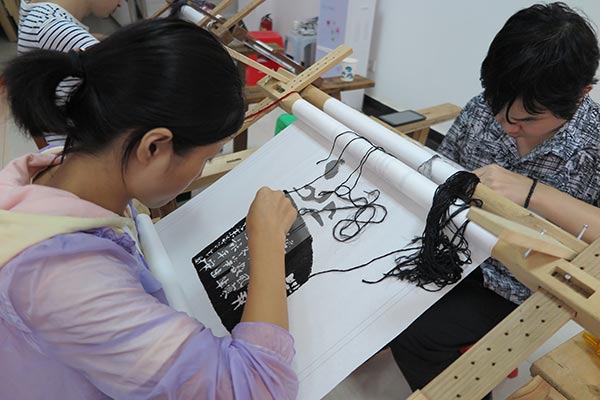 |
|
Workers work on an embroidery. [Photo by Shi Xiaofeng/China Daily] |
The needles used are tailor-made, and are much smaller than those typically used for embroidery on fabric. Special thread is also used to create the effect of traditional ink paintings.
Gu has also developed the flexible curved long and short stitches that are suitable for embroidering calligraphy and paintings on rice paper.
Gu says that traditional calligraphy and ink painting are ideal content for rice paper embroidery because of the material's features.
According to Gu, embroidery on rice paper puts more demands on embroiderers as compared with other types of embroidery.
"You must be very gentle," says Gu. "You can make corrections while embroidering on fabric. But there is no going back while doing it on the paper."
If you put two pinpoints on the same spot, there will be a hole in the paper. Then the entire piece is ruined, he says.
It often takes him months to complete a piece. He once spent four years finishing a large-scale work.
In recent years, Gu's works have been shown at many exhibitions, including overseas, and he has won numerous awards. Gu has also been invited to different places to demonstrate his work and technique.
Now, Gu's works are often presented as national gifts to foreign guests. Many of his works are collected by art institutions and individuals.
For example, one of his works featuring a traditional landscape painting was bought from an exhibition gallery in Shanghai by an Austrian collector last year for 2.8 million yuan, a record high price for his works.
However, most of his and the team's pieces are sold as traditional handicrafts, instead of artworks, at relatively lower prices.
Gu has also broken the rule of keeping the craftsmanship only within his family by founding the Center for Embroidery on Rice Paper.
Over the years, Gu has taken in a score of apprentices, many of whom are physically challenged people.
"For them, it's a craft to make a living, " says Gu.
The center has developed different products, such as paper cuts, commemorative envelopes and screens featuring paper embroidery. The products bring in more than 1 million yuan of income annually for Gu and his apprentices.
According to Gu, it takes three to five years of training for the students to be proficient craftsmen. It requires even longer for them to become artistically mature.
Gu, who is cooperating with local schools to promote the craft among local students, is glad that the family tradition will continue as his son has joined him.
"I hope that embroidery on rice paper can become another calling card for Jiangxi, besides Jingdezhen's ceramics," says Gu.